|
 DENVER, SOUTH PARK and PACIFIC RAILROAD -
NORTHERN DISTRICT
DENVER, SOUTH PARK and PACIFIC RAILROAD -
NORTHERN DISTRICT
Photo Galleries and Short Stories - My South Park Line
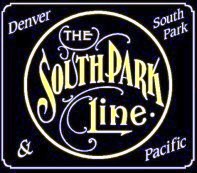 The
DSP&P Northern District operated under the name Rocky Mountain House, Leaverite and Northern Railway.
It was my
outdoor
large scale model railroad, nominally 1:22.5 or G Scale 3 foot
narrow gauge running on Gauge 1 (45 mm) track. It was a
little-known Canadian subsidiary of the Denver, South Park &
Pacific Railroad, serving the fictional towns of Leaverite,
Climax, and
Glacier in west central Alberta. The railway began operations in
2002 and was abandoned in
2017, after the owner moved to a condo in Calgary. The
DSP&P Northern District operated under the name Rocky Mountain House, Leaverite and Northern Railway.
It was my
outdoor
large scale model railroad, nominally 1:22.5 or G Scale 3 foot
narrow gauge running on Gauge 1 (45 mm) track. It was a
little-known Canadian subsidiary of the Denver, South Park &
Pacific Railroad, serving the fictional towns of Leaverite,
Climax, and
Glacier in west central Alberta. The railway began operations in
2002 and was abandoned in
2017, after the owner moved to a condo in Calgary.
Locomotives and rolling stock were put up for sale in
late 2020. Many unique items featured in the photo galleries below
are ON
SALE NOW from this website.
Photo galleries on this page cover a general overview, close-ups of
outdoor mini-scenes, C&S 2-9-0 #30 (a one-of-a-kind model built by
David Fletcher), kit-bashed snow trains and work trains, upgrading
commercial products for added realism, and my 1:1 scale DSSP&P
waycar built to store my large scale trains.
Scroll down to see 100+ photos of "real" trains in action!
 OVERVIEW - OPERATIONS ALONG THE SOUTH
PARK LINE OVERVIEW - OPERATIONS ALONG THE SOUTH
PARK LINE

Overall view of Rocky
Mountain House, Leaverite & Northern Railway,
The town of Leaverite received its name from the ranchers' term for
large glacial erratics (rocks) left over from the last ice age - - -
"leave 'er right there. it's too big to move". The largest leaverite
in the world is at Okotoks, Alberta, about 160 miles
south of the RMH,L&N location. Okotoks is a Blackfoot word for "Big
Rock". Calgary, the major city close to the Big Rock, is the home of a well known brewery, sending Big
Rock beer across North America.
 The
Okotoks rock weighs in at 16,500 tons and travelled about 400 miles
from Mount Edith Cavell, near Jasper. The biggest rock on the RMH,L&N
weighs 4 tons and is about the size of an old Volkswagon. This
monster, plus a dozen smaller rocks, were found on our ranch as we
cleared bushland for grazing pastures. The
Okotoks rock weighs in at 16,500 tons and travelled about 400 miles
from Mount Edith Cavell, near Jasper. The biggest rock on the RMH,L&N
weighs 4 tons and is about the size of an old Volkswagon. This
monster, plus a dozen smaller rocks, were found on our ranch as we
cleared bushland for grazing pastures.
 Placing leaverites on the RMH,L&N garden railway. Placing leaverites on the RMH,L&N garden railway.
The RMH,L&N is about as small a garden railway as can be built
and still be interesting. It is 18 x 38 feet with a two level
mainline laid out as a folded dog-bone. The large rocks hide the
train from view in many places. We generally run two trains
following each other, making for some interesting operational
problems.
An
eight train transfer table is hidden in a fullsize replica of DSP&P
waycar #60.. A crushed brick sidewalk provides access on all sides
of the railway.
All locomotive, revenue freight, and passenger equipment is on lease
from the Denver, South Park & Pacific Railroad. These include 6
Moguls, 2 Consolidations, and 3 Mason Bogie.
Passenger and freight cars are all DSP&P equipment, either leased or
second hand. Maintenance of Way equipment is on loan from the
Rocky Mountain House,
Nordegg and Pacific Railway. Almost all the rolling stock
has been modified or kit-bashed in some way to make it unique to
this railway.
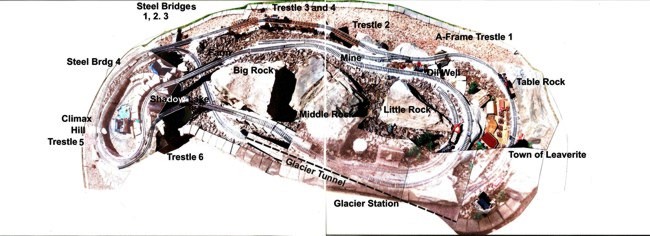
Satellite photo-mosaic of Rocky Mountain House, Leaverite & Northern
Railway. North is to the right.
Click here for larger image
(300 Kb)
The garden railway, with ranch-house and 160 acres of ranch land, was put
up for sale in 2016. The prized locomotives and rolling stock were
put on display in my condo. Two trains were left for the new owners,
the scenic modules were sold to a neighbour, and the balance of the
rolling stock was put on consignment. Photos on this webpage show
the railway in its prime.
Take a quick tour with this
Slide Show,
then do what the song says and Come Back to this page to read
the captions and view 100+ great photos.
 Photo
Gallery #1 - MY SOUTH PARK LINE Photo
Gallery #1 - MY SOUTH PARK LINE
Photos taken in 2008 -- 2012 by the author.
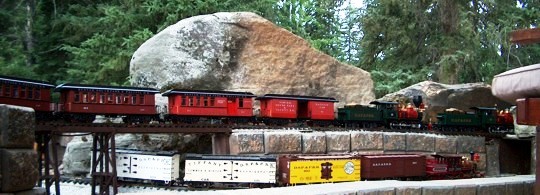
DSP&P Moguls 17 and 18 pull a seven car passenger express northbound
on the Highline, DSP&P Mason Bogie #15 "Breckenridge" leads a reefer
consist into Glacier Tunnel.

Head shot of #15 "Breckenridge" about to enter
Glacier Tunnel with the Express on
the Highline above.
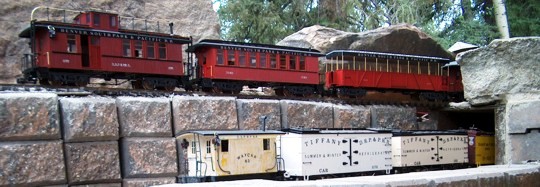
Kit-bashed waycar #69 trails the reefers
through Glacier Tunnel.
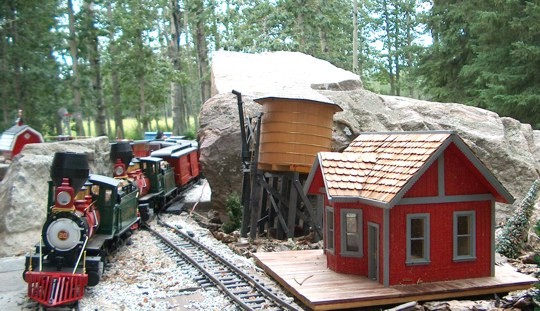
The double headed express snakes into Glacier
station.
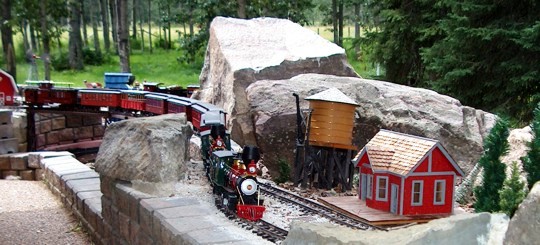
Big Rock stands above the express as it pulls into Glacier station,
Middle Rock and Little Rock stand behind the station.
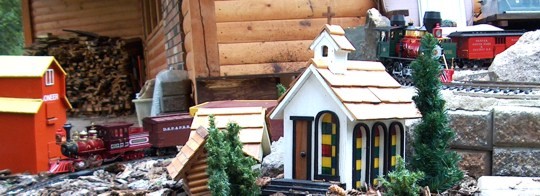
DSP&P #15 enters Leaverite in front of the
Pioneer grain elevator after clearing
Glacier Tunnel.
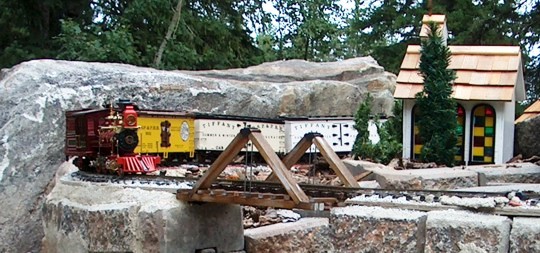
DSP&P #15 leaves Leaverite, approaching Bridge
#1, a pony truss.
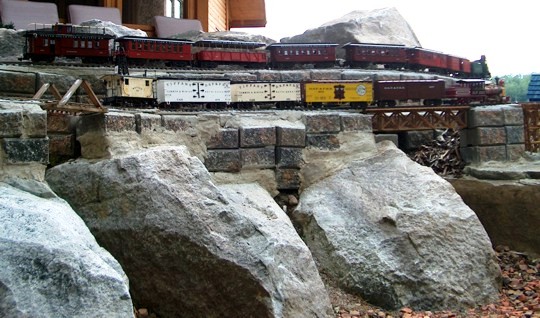
The double headed express and the reefer drag
meet again on the southbound run, held
up on the steeply sloping side yard by more leaverites.
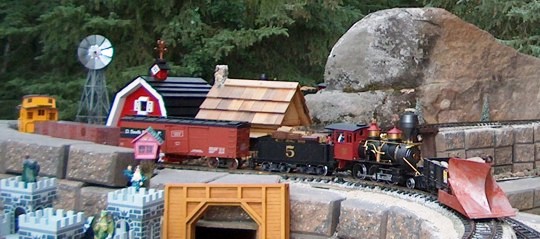
C&S #5 heads the MOW train past Rocking "Are"
Ranch, pushing the snowplow, which
subs as a track cleaning car.

Broadside of the reefer drag with
"Breckenridge" at the point.
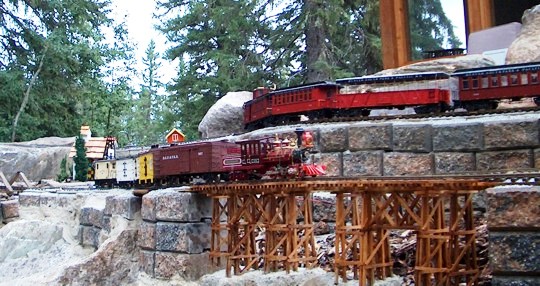
"Breckenridge" pulls onto Trestle #3 while the
tail car approaches Trestle #2, passing the
derrick for the Crain #1 oil well.

"Breckenridge" leaves Trestle #4 and
approaches the Lower Steel Bridge, while the
express crosses Upper Steel Bridge.
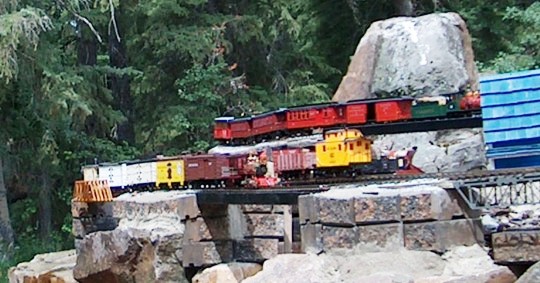
The double header
crosses over the MOW train at Shadow Lake while
"Breckenridge" pulls onto the Lower Steel Bridge.
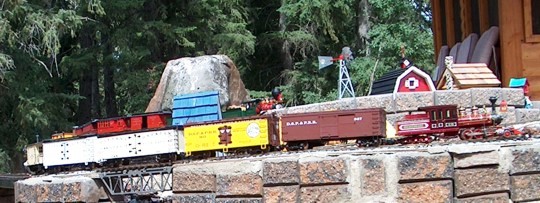
"Breckenridge" starts the long pull up the
3.5% grade of Climax to the Highline.

Finishing the 3.3% grade on the sharp curve
takes a sensitive hand on the throttle
to prevent spin-outs.
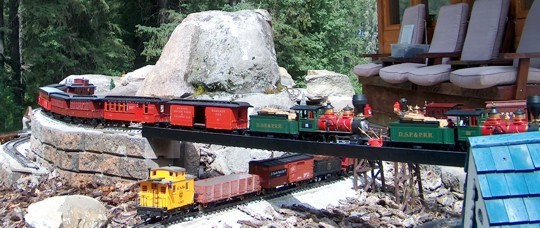
DSP&P Mogul # 18 with a four car passenger
train crosses over Shadow
Lake and
MOW snow train.
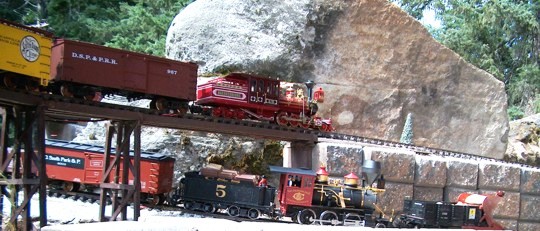
"Breckenridge" on the high trestle approaching
Glacier station, crossing over C&S #5
with the snowplow train.
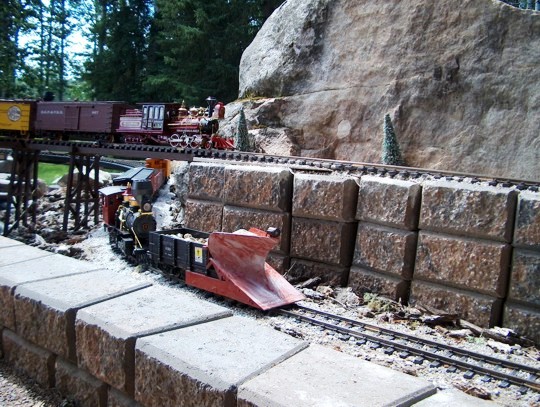
The snowplow is about to enter Glacier Tunnel
with "Breckenridge" on the Highline.
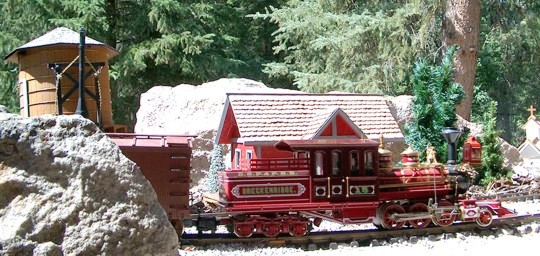
"Breckenridge" pauses for orders after taking
on water at Glacier tank.
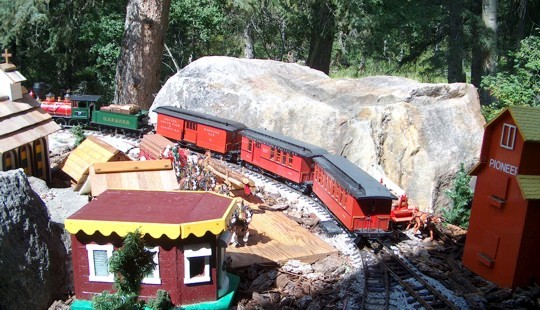
The Sunday local leaves Leaverite in the early
morning sun.

C&S #5 hauls LCL freight and open loads of
steam traction, thrasher, and new-fangled
automobiles across Lower Steel Bridge, with Big Rock overseeing
operations.

C&S #5 on Trestle #3 with the open loads.
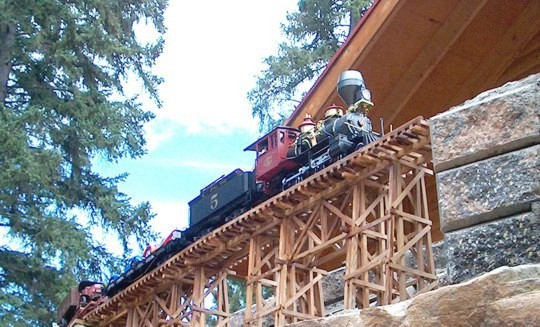
C&S Mogul #5 on Trestle #3.

The open loads southbound.

DSP&P Consolidation #63 heads out with the
local way freight.

#63 crossing Trestles 3 and 4 with the local
freight in front of Middle Rock and Big Rock.
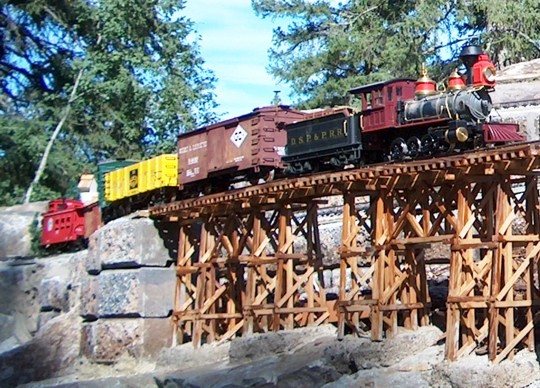
Trestle #3 carries DSP&P #63 with Gorre and
Daphetid boxcar and Victor Mining gondola
full of gold ore.

DSP&P Mogul #71 heading south with the daily through
freight with waycar #69 on the tail.
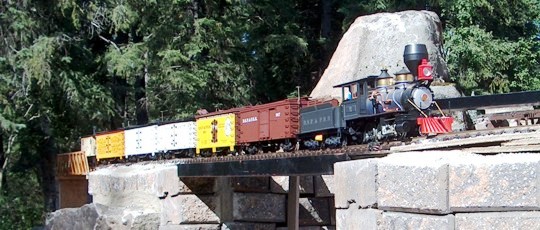
Sunshine on Leaverite country, with DSP&P Mogul #71 crossing the Lower Steel
Bridge.
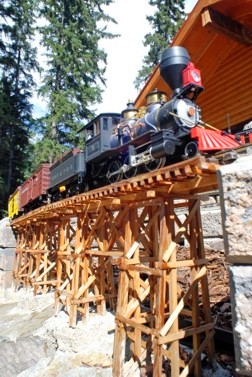
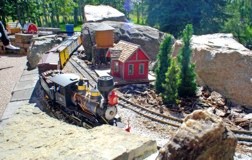
DSP&P #71 on Trestle #3 (left) and running through Glacier
(right) - Leo deGroot
photos.
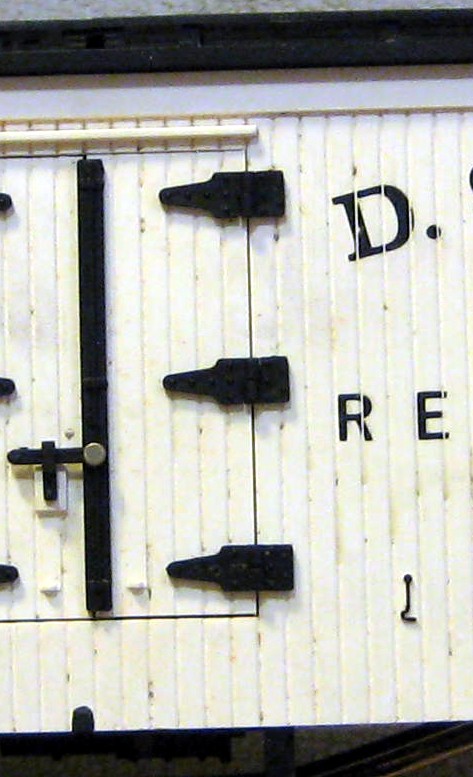
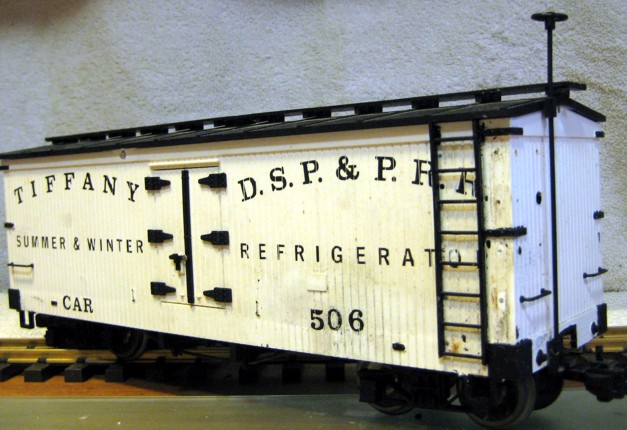
I love kitbashing
and improving commercial models to attain a little more realism.
Door
hooks on LGB reefer were touched with black paint (lower
left). All hardware, brake
staff, and truss rods were painted black, ice hatches
removed, air vent and ladders added, and a new road number
inscribed, making the LGB reefer closer to the 1880 prototype.
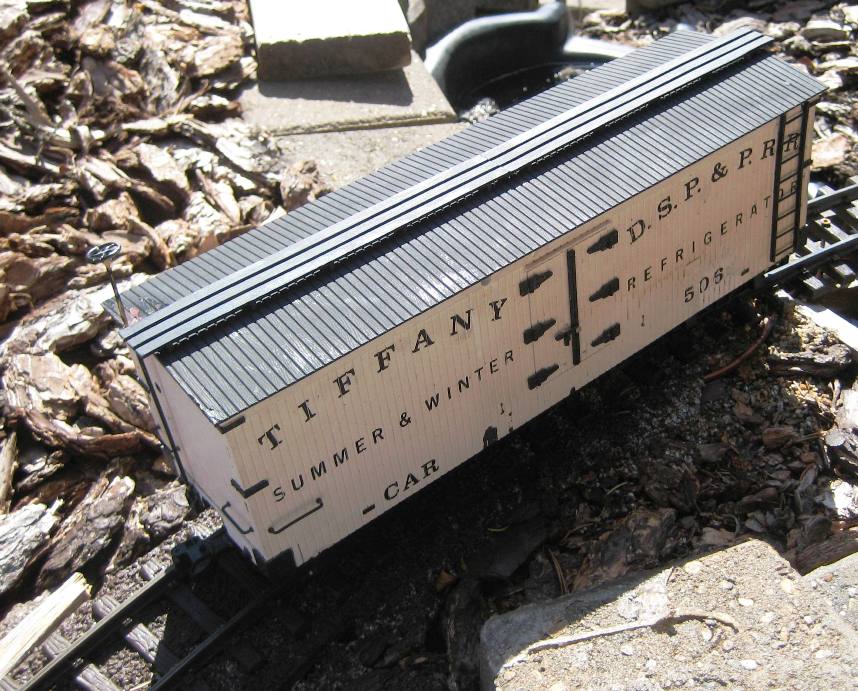
The Murphy patented "outside" metal roof didn't arrive until
1905 so no DSP&P car could have carried one until well along in
C&S service.
Converting the poorly rendered Murphy roof on the LGB,
Delton, and USA Trains reefers and boxcars to a simulated wood
roof makes a huge difference. The cure is to purchase some well
used Bachman 933xx series boxcars at auction and snap off the
roof - it is simulated wood, and the only one available in
large scale. It needs to be shortened a bit in a miter saw to
replace the Delton and USA Trains roof, and shortened even more
for the LGB cars, then it just snaps into place.
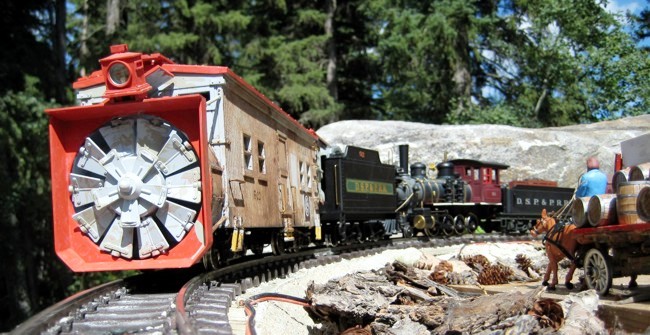
DSP&P Consolidation #64 pushes Rotary O2 enroute to Climax Hill. See
more snow train action further down this page.
BELOW:
Interview and Photos published in "The Mountaineer" newspaper, Rocky
Mountain House, Alberta, 26 July 2016. Photos and article by Logan Schenk, Staff Reporter.


 PHOTO
GALLERY #2 - Outdoor
Mini-Scenes PHOTO
GALLERY #2 - Outdoor
Mini-Scenes
 The Rocky Mountain House, Leaverite and Northern Railway
was an
outdoor,
large scale model railroad, nominally 1:22.5 or G Scale 3 foot
narrow gauge running on Gauge 1 (45 mm) track. It is a
little-known Canadian subsidiary of the Denver, South Park &
Pacific Railroad, serving the fictitious towns of Leaverite and
Glacier in west central Alberta. The railway was abandoned in
2016 and the locomotives and rolling stock put up for sale in late
2020. Many unique items featured in the photo gallery below are
ON SALE NOW
from this website. The Rocky Mountain House, Leaverite and Northern Railway
was an
outdoor,
large scale model railroad, nominally 1:22.5 or G Scale 3 foot
narrow gauge running on Gauge 1 (45 mm) track. It is a
little-known Canadian subsidiary of the Denver, South Park &
Pacific Railroad, serving the fictitious towns of Leaverite and
Glacier in west central Alberta. The railway was abandoned in
2016 and the locomotives and rolling stock put up for sale in late
2020. Many unique items featured in the photo gallery below are
ON SALE NOW
from this website.
Apart from kitbashing unique rolling stock for the RMH, L&N Ry, my
favourite modeling task is building mini-scenes -- scenes with a
central focus that will catch the eye, and also blend into the overall track and scenic
arrangement of the layout. Stations, water tanks, junctions, small
townscapes, mines, oilfields, farmsteads and similar settings are
logical objectives. Details and era-specific transportation and
architecture help enforce the illusion of reality.
Such scenes are easy enough on indoor railways (see my
indoor railway story)
but a little more difficult outdoors, due to the ravages of weather
and wild critters. Each mini-scene is a separate module that can be
moved indoors for winter storage, renovation, or impending hail
storms. Here are some completed mini-scenes on the RMH, L&N.
Photos taken 2014 by the author and Ian Crain.

C&S 2-6-0 Mogul #5 is
swinging west at Caboose Junction. The station house is an old
caboose with freight and passengers waiting for the eastbound
express. A horse and buggy are passing the station. Grass is
outdoor turf and trees are Pinus Plastica. The grass overlaps the
plywood baseboard so that it snuggles up to the ballast along the
side of the track.
.
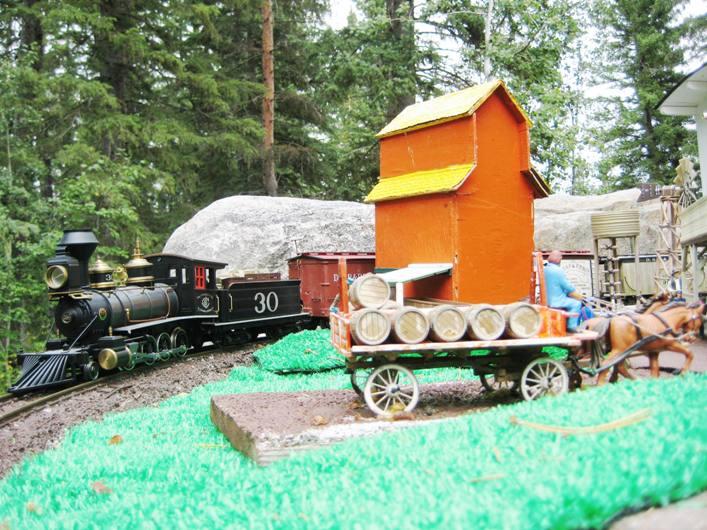
The Pioneer grain elevator
at Leaverite is a stand-alone building, a modified birdhouse with a nice shingled
roof. Some grass and a grain wagon provide the detail. Trees in
the background are at Caboose Junction.
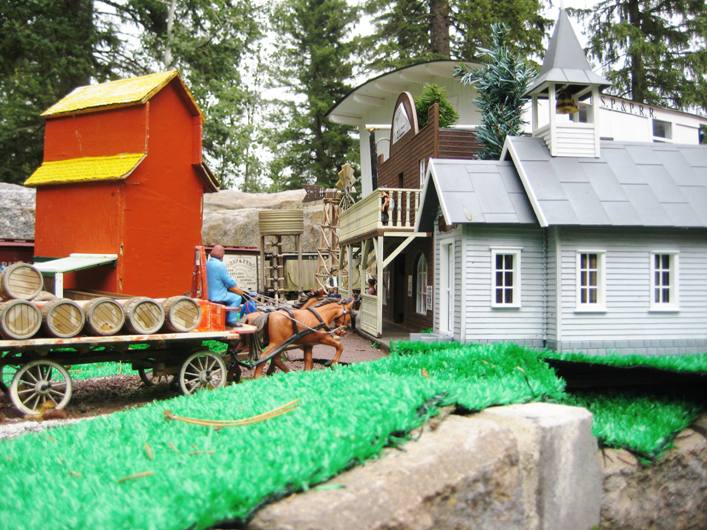
Downtown Leaverite is represented by the old country church and the
Black Hills Saloon along Railway Avenue, opposite the grain
elevator.
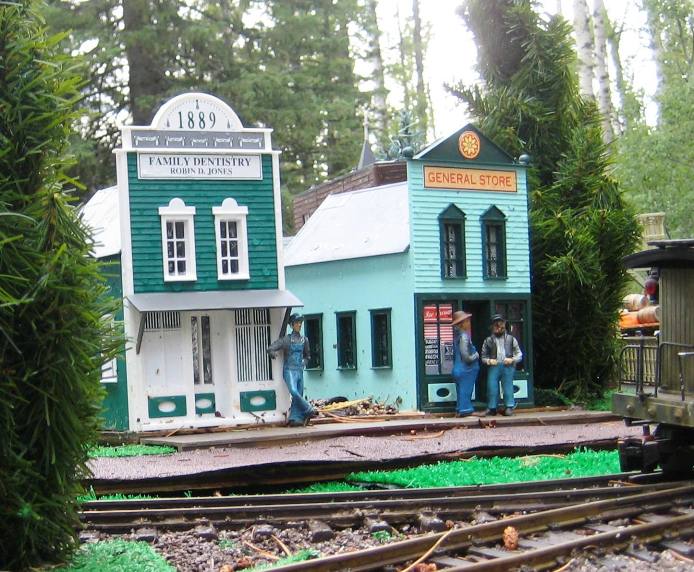
Uptown Leaverite is blessed with a substantial office building and
general store.
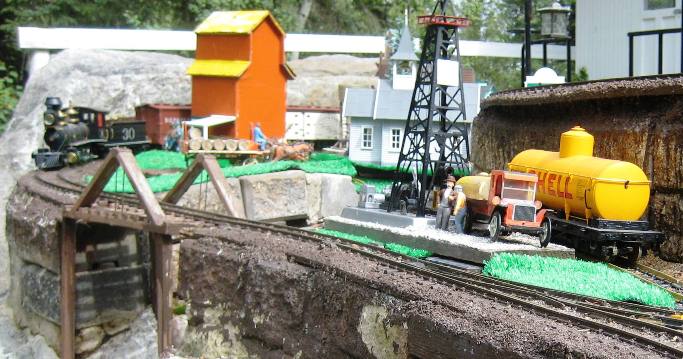
The Crain #1 oilwell derrick
is just on the edge of town, with the old church in the background.
The derrick is a Lionel product, about half-size
for for G Scale, but about right for a small layout.
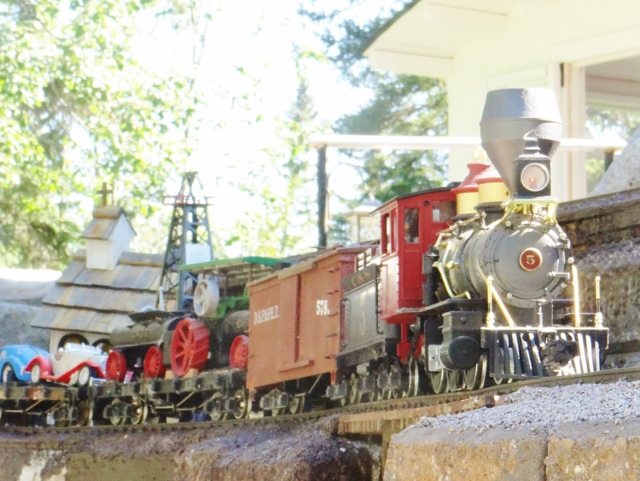
Mogul #5 trailed by a DSP&P boxcar
and a series of flatcars with open loads, the first a large steam
traction engine for delivery to a "modern" farmer. Each flatcar is
its own mini-scene.
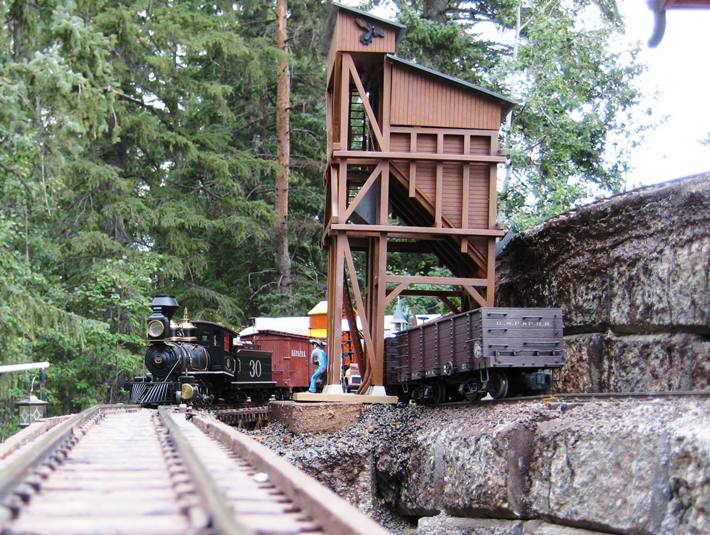
Here's the Randy
Andy Mine at the Pallisades. It's a Pola kit and the timber work is
quite impressive.
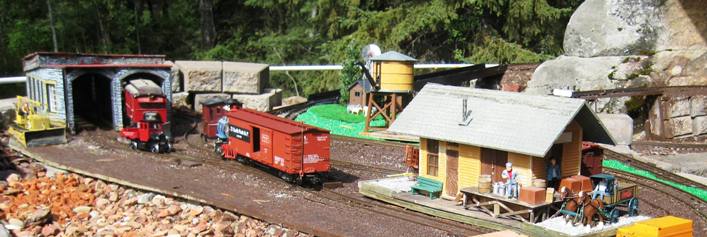


Three views of roundhouse and freight house at Climax Hill
yard. The roundhouse at left
is kitbashed from several Pola stone engine house kits. Both buildings are stand-alone mini-scenes
with lots of details. The yard goat is a Lionel 0-6-0T, representing
a rebuilt DSP&P #1 "Fairplay". The road foreman's jitney and
the railbus just outside the roundhouse are Delton products.
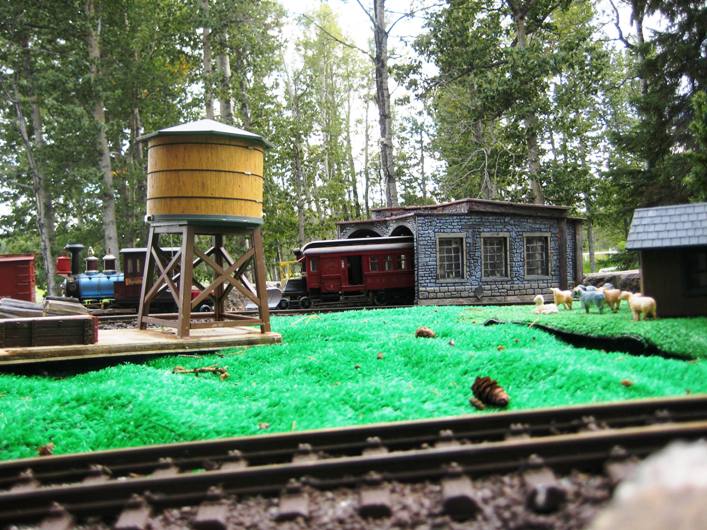
The tank at Climax Hill and the train crew bunkhouses, with a few
sheep for company. DSP #1 "Fairplay" is just visible in the
background.
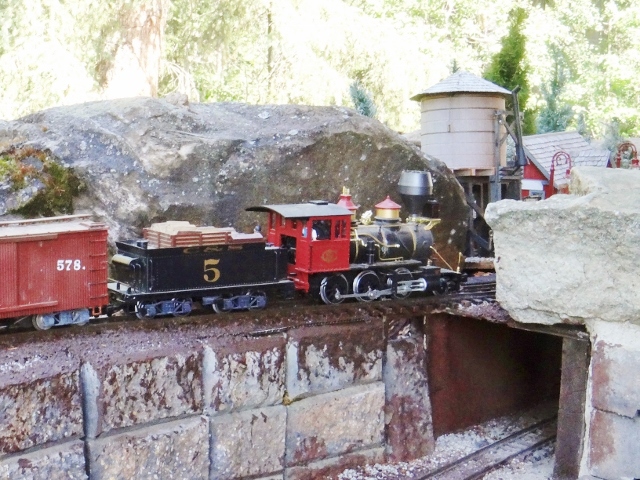
Mogul #5 pauses for water at the tank beside
Glacier Station. This is an Alpine forest area below Big Rock
Mountain.

Head on view of #5 at Glacier Station. Grass and trees are as at Caboose
Junction. Wood stockpile for the locomotive is a kitbash of some
spare LGB parts. Platform lights are Lionel streetlights. Passengers
and baggage are ready for the next westbound passenger train. This
station is all wood.
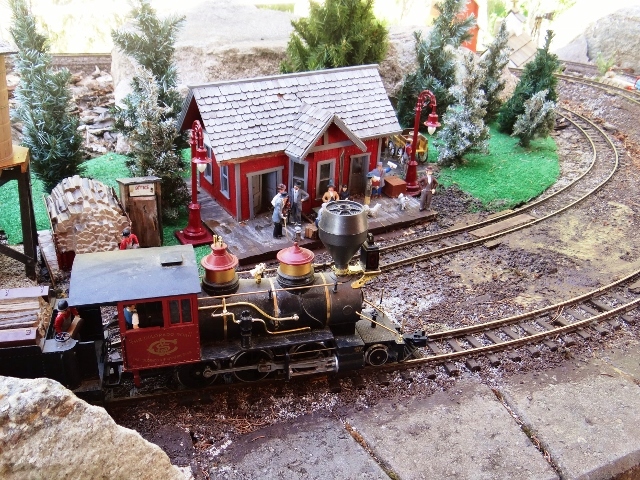
Glacier Station again with a
good-sized group waiting for the next local passenger train,
showing more details, trees and grass. The whole module lifts out
for storage. Track is a model too. Ballast is coarse chicken grit
mixed with exterior grade white glue, painted with mahogany stain
to match the colour of the Big Rock, the centerpiece of the railway.
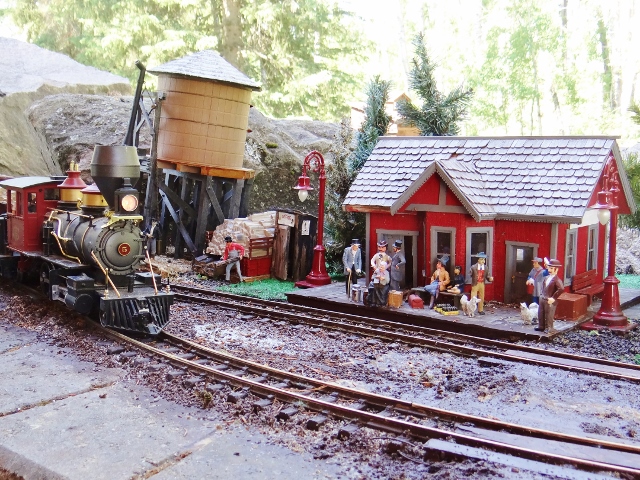
The front view of Glacier
Station. So far, this scene has survived 7 years of sun and rain and
a bit of hail. The green grass and green trees have not faded yet.
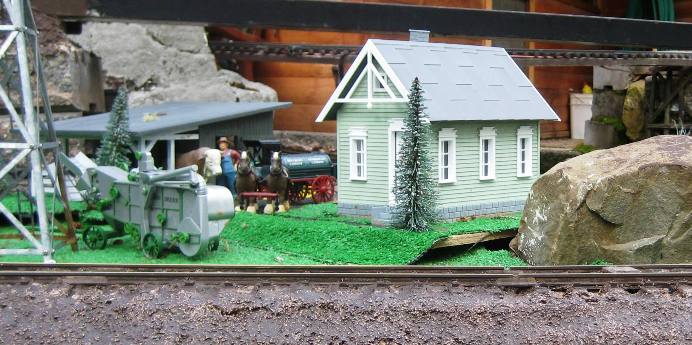
Close up of the farmhouse and stable. The prize-winning Horned
Hereford bull is being led from his stall in the barn for a trip to
visit the cow herd.
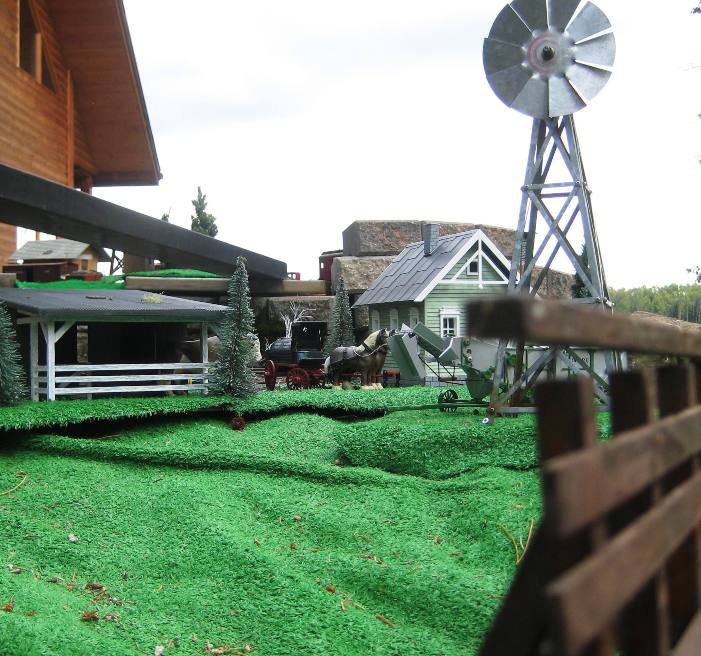
Overview of the
ranch and wind pump. A kerosene-fueled tractor and horse team with
wagon place the era.

The Hereford cattle lounging
beside Shadow Lake are bracketed by the Big Steel Bridge (a six inch
steel channel) and the Shadow Lake Trestle in the foreground. The
grass is nice and green so it must have rained recently.

The mixed train with a reefer and combination baggage passenger
caboose is headed up Climax Hill, past the cowboy camp at Lone Pine.
The chuckwagon and cowboys are 1:32 scale, making the canyon look
deeper and farther away than they really are.

A lot of what I would
like to do in a mini-scene is too fragile for outdoors, so I keep
three 4-foot modules undercover to illustrate what can be done: Lost
Lemon Mine (left) with Brewster, an 0-2-2-0 working ore car,
Daly Glen Tank and Station (center), Foggy Bottom Lighthouse and
Poisson Ratio's Fish Plant (right).
Click here for larger image
(1.0 Mb)
 PHOTO GALLERY #3 - C&S CONSOLIDATION #30
PHOTO GALLERY #3 - C&S CONSOLIDATION #30
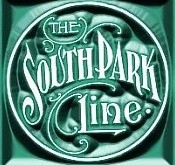 The RMH,L&N
RR portrays the Denver, South Park and Pacific Railroad around 1880
to 1885, with some minor time-sliding so I can incorporate some
interesting items of rolling stock, like a rotary snowplow and a
Mack AB dump truck on a roll-on roll-off flatcar. I also run C&S
Mogul #5 with its caboose C&S #301 and C&S
Consolidation #30. The RMH,L&N
RR portrays the Denver, South Park and Pacific Railroad around 1880
to 1885, with some minor time-sliding so I can incorporate some
interesting items of rolling stock, like a rotary snowplow and a
Mack AB dump truck on a roll-on roll-off flatcar. I also run C&S
Mogul #5 with its caboose C&S #301 and C&S
Consolidation #30.
My model of C&S #30 is a one-of-a-kind built by David
Fletcher for Aristocraft, as a prototype for a new product. It was
never put into production, so this was one of my prized locomotives.
During my down-sizing from a 160 acre ranch to an 1150 sq ft condo,
I had to make some really tough decisions. One was to donate some
rolling stock and locomotives to the Denver, South Park and Pacific
Historical Society. David's beautiful C&S #30 is now on display at
the Roundhouse in Como Colorado.
Here is part of David's description of his work: "These
Aristocraft "Delton Classic" models originally had the
superstructure sit too high above the wheels in order to fit the
gearbox, which spoiled the low-slung look of a Baldwin 2-8-0. I
developed a means to lower the model down to correct height, and
this one was so modified in around 2006 when the model was purchased
new. The engine is nice and low slung with the wheels now correctly
set about the piston centre line. The only other change made was to
repaint the boiler jacket with Testors Metalizers Gun Metal to
produce the proper Russia iron colour for the jacket. The rest of
the model is painted and lettered to original factory form. The
livery and lettering of this model represent the C&S style from
1900."
This Photo Gallery includes a series of photos of C&S #30 at various points
of interest on the RMH, L&N. Camera is an ancient Canon digital point-and-shoot.
Photos taken in 2014.
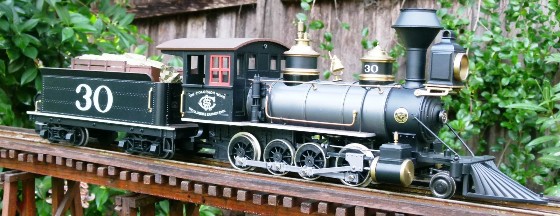
C&S #30
Builder's Photo by David Fletcher
C&S #30 was a Baldwin built 2-8-0 Consolidation delivered to the DSP&P
in 1880. It was originally numbered DSP&P #50 and became DSP&P #190
in 1885. Her full-size sister, DSP&P #191, is at the Colorado Railway Museum.
See David's CAD drawings of DSP&P #51 / 191
HERE.

C&S #30 sneaks past the Pioneer grain elevator at Leaverite. The
horse-drawn wagon with beer for the Black Hills Saloon has just
crossed the track in front of the locomotive.

C&S #30 headed north at Lone Pine.
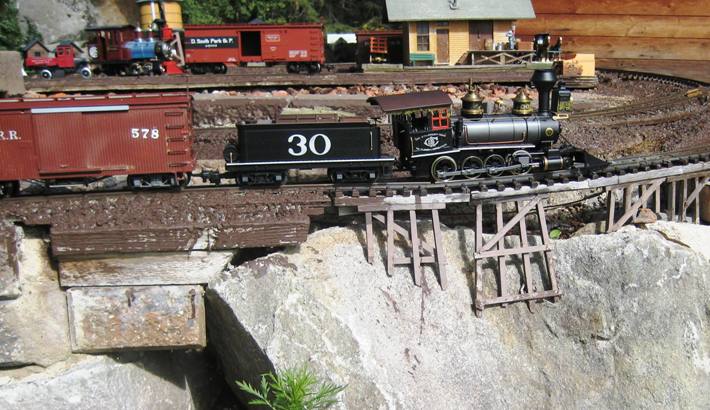
C&S #30 climbing Climax Hill, with the Climax yard and freight depot
in the background.
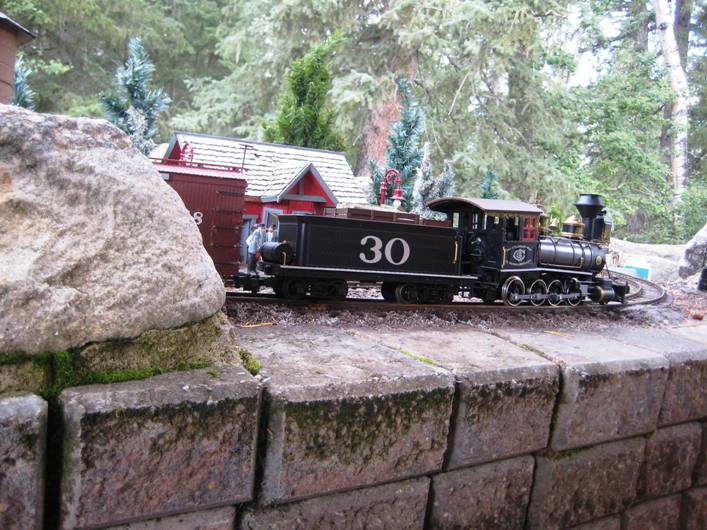
C&S #30 at Glacier Station, after taking on water.
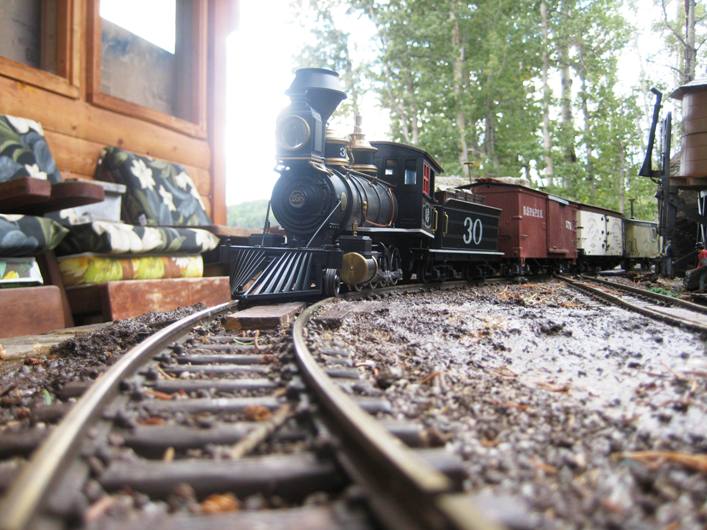
Headshot of C&S #30 and her short freight train, stopped for orders
at Glacier.

C&S #30 southbound on the High Line, passing the first oil well in
Alberta.
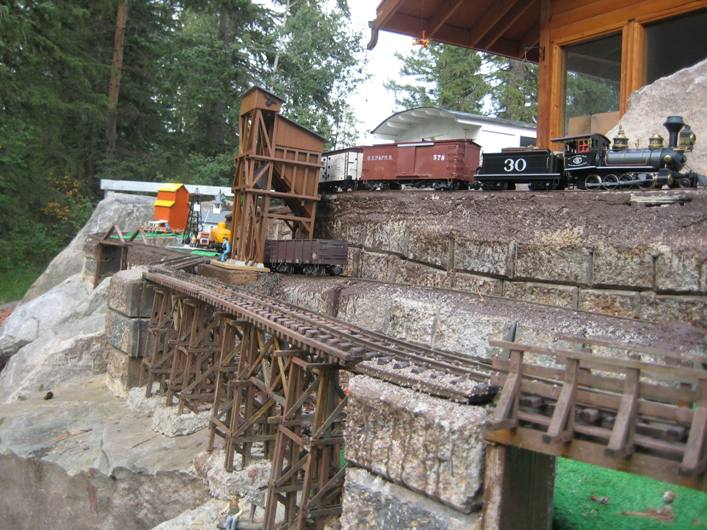
This image shows why the High Line is called the High Line.

C&S #30 on Bridge 3.
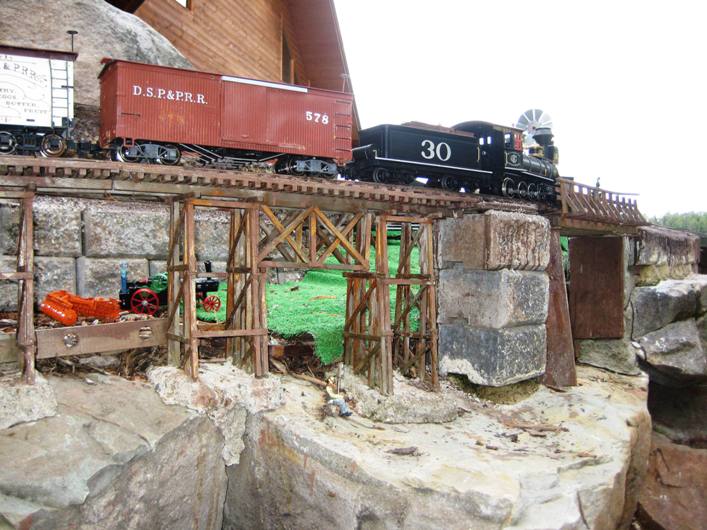
C&S #30 on Bridge 4, silhouetted against the evening sky.
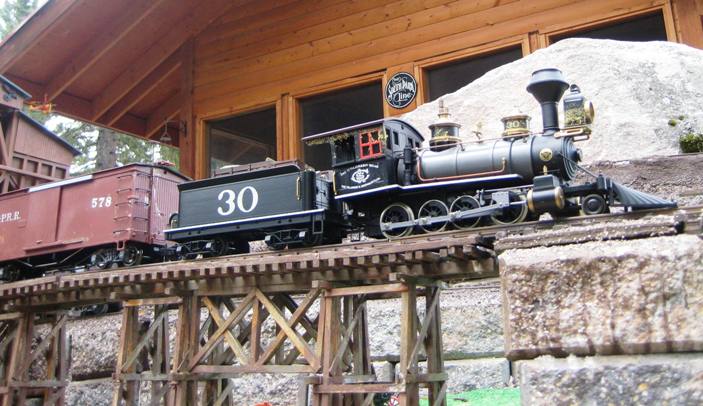
C&S #30 on Bridge 5.
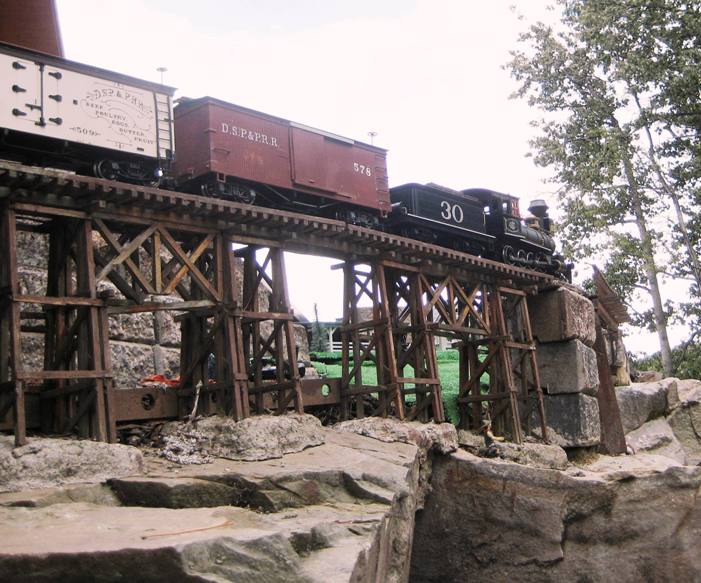
Another shot on the bridge.
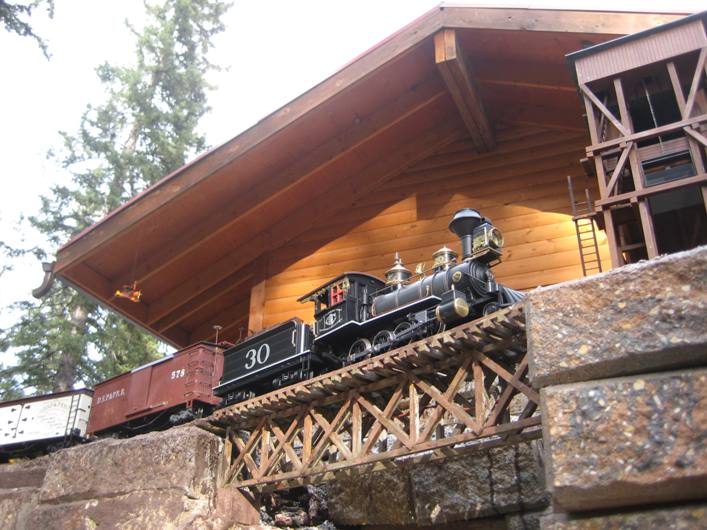
Number 30 at sunset. approaching the Randy Andy Mine at the Pallisades.
 PHOTO GALERY #4 - SNOW FIGHTING TRAINS
PHOTO GALERY #4 - SNOW FIGHTING TRAINS
 Snow fighting is a big issue on the Rocky Mountain House, Leaverite
and Northern Railway. Specialized equipment and highly trained
crews keep the tracks clear (most of the time). Snow fighting is a big issue on the Rocky Mountain House, Leaverite
and Northern Railway. Specialized equipment and highly trained
crews keep the tracks clear (most of the time).
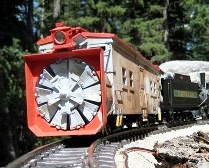 The Snow Train
with rotary snow plow and support cars are shown in the photo
essay below. Most of the train is pretty grubby except the caboose
fresh from the paint shop and the new tender for the plow. The Snow Train
with rotary snow plow and support cars are shown in the photo
essay below. Most of the train is pretty grubby except the caboose
fresh from the paint shop and the new tender for the plow.
The snow train consists of Rotary O2 and tender, water tanker W69,
coal car O174, kitchen car O185, bunk car O183, and a waycar.
Wedge plow O3 and steam shovel O4 are also available for snow
service.

Snow train snakes
around Big Rock on the High Line.

DSP&P Consolidation #64 pushes Rotary O2 enroute to Climax Hill. The
horses pulling the beer wagon seem unconcerned by the rattling of
the rotary as it passes.

The original USA Trains rotary was freelanced into DSP&P
Rotary O2..
To improve visibility in blowing snow, a cupola has been added. A
roof and backhead were added at the rear using Hartland parts, as
were a bell and whistle on the roof. The tender is from an LGB Mogul
with sound added.

DSP&P Snow Train on
Trestle #4. The plow has been kitbashed to include boiler backhead
detail, fireman's platform and protective roof over tender. Side
curtains are still at the laundry. The tender
is a standard gauge unit converted to narrow gauge, rescued from the CPR
Ogden Shops (contains steam sound and whistle for plow).

The complete snow
train: caboose, bunk / tool car, kitchen car, coal car, water car,
2-8-0 Consolidation #64, plow tender, rotary plow O2. A wedge plow is
also available for light duty.

Snow train leaving
the Town of Leaverite.
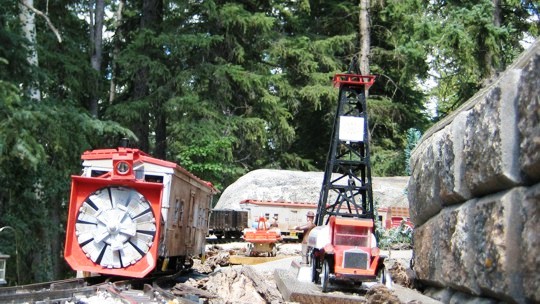
Passing Crain #1 oil
derrick and Mack AB tank truck.

Passing Rocking "Are" Ranch, on the way to Climax Hill,
crossing Lower Steel Bridge.

The other plow, wedge
O3, returning from a cleanup run along the base of Big Rock. DSP&P
#15 "Breckenridge" is above, crossing Trestle #6 over the
eastern tip
of Shadow Lake on the High Line.

Wedge plow O3 sitting in the yard during a summer respite. This is
also my track cleaning car, with emery cloth under the plow blade
and a scrubbing pad under the body. It was kitbashed from an
Aristocraft plow, shortened by 3 inches, with a Hartland headlamp
added to backdate the original modern headlight.
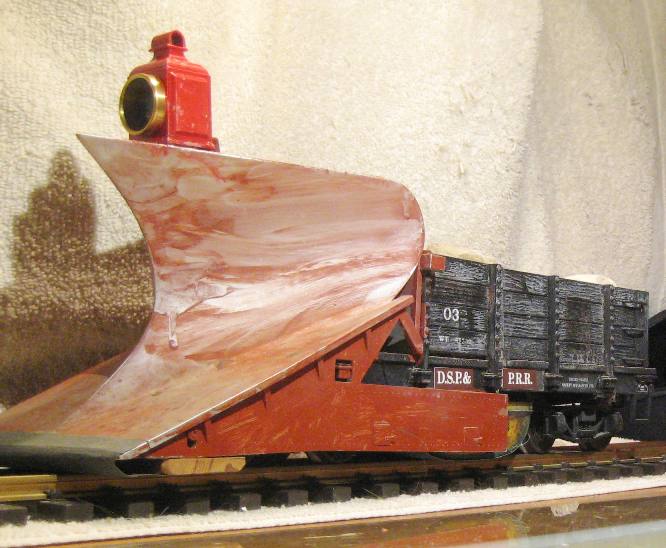
Headshot of DSP&P wedge plow O3 showing rusting plow blade before it
gets scoured clean and shiny by the icy snow next winter.
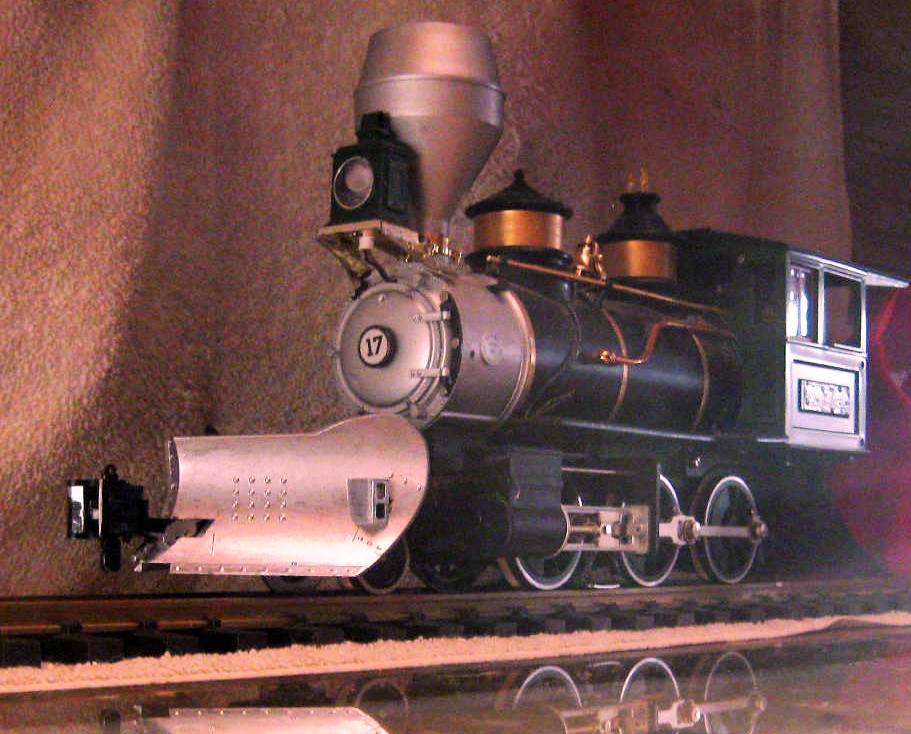
DSP&P 2-6-0 Mogul #17 is shown here in the reflected light of the
engine house, with its pilot-mounted snow plow, ready for its
early morning run to Glacier and Leaverite.

When the snow and rock falls from avalanches are too dangerous for
the rotary plow, Steam Shovel O4 can be brought forward to clear the
line. The enclosed cab is a real comfort to the crew in the minus 40
temperatures of the North. This is kitbashed from an LGB flatcar and
a JS Woodcrafts steam shovel with the track assembly removed.
 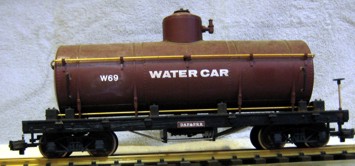
Snow train auxiliary cars: Coal car O174 and Water car W69.
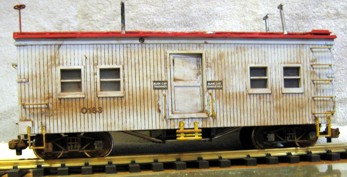 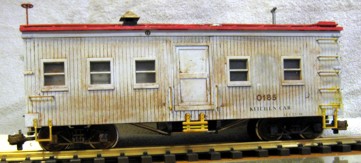
Snow train auxiliary cars: Bunk/Tool Car O183 and Kitchen car O185
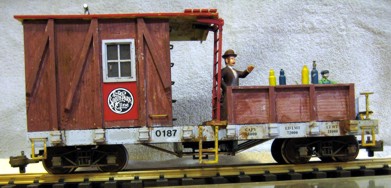 
Snow train auxiliary cars: Work Caboose O187 and well-worn spare
Waycar #90
 PHOTO GALLERY #5 - WORK TRAINS
PHOTO GALLERY #5 - WORK TRAINS
 Maintenance of track and the right of way, and rescuing wrecks, are big issue on the Rocky Mountain House, Leaverite
and Northern Railway. Specialized equipment and highly trained
crews keep the tracks in shape (most of the time). The variety
of work or maintenance-of-way (MOW) cars are shown in the photo
essay below. Most of the work train is kitbashed from commercial
rolling stock or parts to make each car a unique model. Maintenance of track and the right of way, and rescuing wrecks, are big issue on the Rocky Mountain House, Leaverite
and Northern Railway. Specialized equipment and highly trained
crews keep the tracks in shape (most of the time). The variety
of work or maintenance-of-way (MOW) cars are shown in the photo
essay below. Most of the work train is kitbashed from commercial
rolling stock or parts to make each car a unique model.
Building work train cars
was the most fun I've had
in a long time. I started with USA Trains work cars but backdated them into the
1880's, shortened the long flatcars to match the 27 foot LGB cars, put truss rod
underframes under them, replaced modern trucks with archbar versions, and
generally cluttered them up with tools, spare parts, and dirt -- lots of dirt.
The wrecker, steam shovel, and pile driver started as regular LGB flatcars with
JS Woodcraft steam shovel or home made parts.
I also built more modern pile
driver and steam shovel cars for a friend using diecast diesel powered hoisting
cabs and booms.
He also picked up my USA Trains 1960s era Brownhoist wrecking crane to add to
his roster.

My
favorite train is my series of work train cars.
These have been extensively modified - the long flatcars were
shortened to take USA Trains truss rod underframes. This allows
these cars to match the length of LGB equipment and negotiate
the sharp curves without snagging scenery or looking silly. Lots
of junk, dirt, tools, and supplies decorate each car.
Click here for
large image (240KB)
huge image (2.4 MB)

Steam Shovel O4 can be brought forward to clear the
line of avalanches and rock falls, or to widen a cut or clean up a
ditch. The enclosed cab is a real comfort to the crew in the minus 40
temperatures of the Northern winters. This is kitbashed from an LGB flatcar and
a JS Woodcrafts steam shovel with the track assembly removed.
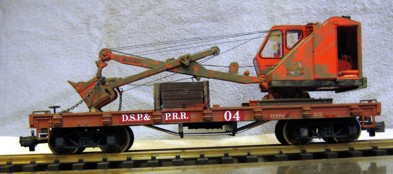
Add a diesel powered shovel for a more modern ditcher.
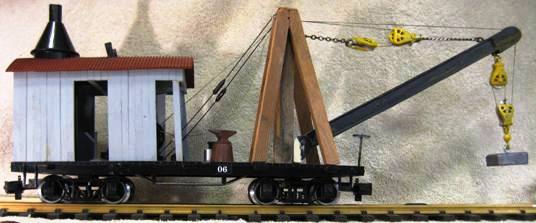
Starting with steam shovel parts and some Ozark Miniatures
pulley blocks,
a wrecking crane appears, loosely following a DSP&P folio drawing.

The wrecking crane tender/boom car includes lots of tools, parts,
rope, chains, junk, and a guard goat.
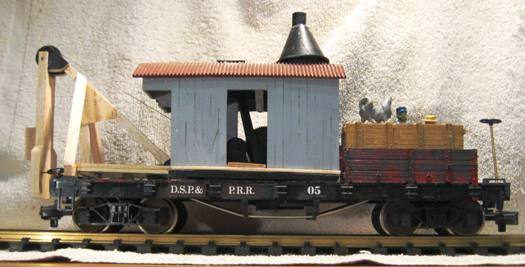
The pile driver uses the same steam hoist with a
free lanced mast holding
the pile driver's hammer.
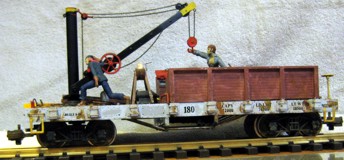
The derrick
car was backdated by shortening the flat car
and adding a truss rod underframe.
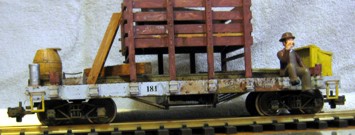
The USA Trains rail and tie car
was also shortened and loaded
with .... rails and ties.

Also
shortened, the work caboose has tools and
equipment storage.
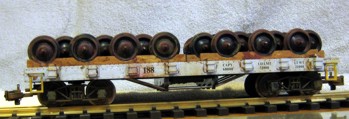

The truck and wheel cars are less interesting
but are an essential part of any wrecking
consist.


Outfit cars just need to look used and dirty. The railroad name
has long
since worn off. These are the bunk and kitchen
cars for both the work and snow trains, and have
been modified to include the simulated wood roof
of the era.
 Photo Gallery #6 -
Dressing Up Commercial Rolling Stock
Photo Gallery #6 -
Dressing Up Commercial Rolling Stock
 Commercial
large scale rolling stock leaves a lot to be desired if you want
to be faithful to the idea of the DSP&P. A few locomotives were
manufactured that are reasonable representations, but most
other rolling stock is generic.
This
page illustrates a few of the things that can be done to commercial
products to make them more like the original and to make them
unique to my railroad. To see what DSP&P rolling stock should
look like, see my DSP&P
Rolling Stock page, where
accurate models in various scales are portrayed. Commercial
large scale rolling stock leaves a lot to be desired if you want
to be faithful to the idea of the DSP&P. A few locomotives were
manufactured that are reasonable representations, but most
other rolling stock is generic.
This
page illustrates a few of the things that can be done to commercial
products to make them more like the original and to make them
unique to my railroad. To see what DSP&P rolling stock should
look like, see my DSP&P
Rolling Stock page, where
accurate models in various scales are portrayed.
The
Rocky Mountain House, Leaverite and Northern Railway has many
interesting and unusual items on its roster. As the long
forgotten Canadian subsidiary of the Denver, South Park and
Pacific Railroad, most of the equipment is borrowed or leased
from the DSP&P.
Accurate large scale models of DSP&P locomotives and rolling
stock are rare and mine are no exception. Using commercial large
scale models, I have accepted some "as is", kitbashed others,
and relettered
others to obtain variety and colour, giving an impression of
what it might have been like in the
1879 to 1889 era. Some were modified by other modelers and
purchased from eBay, then further adapted by me. Weathering varies from slight to really
grubby, depending on age and class of service. The MOW cars are
the most interesting, but the open loads and reefers are pretty
nice too.
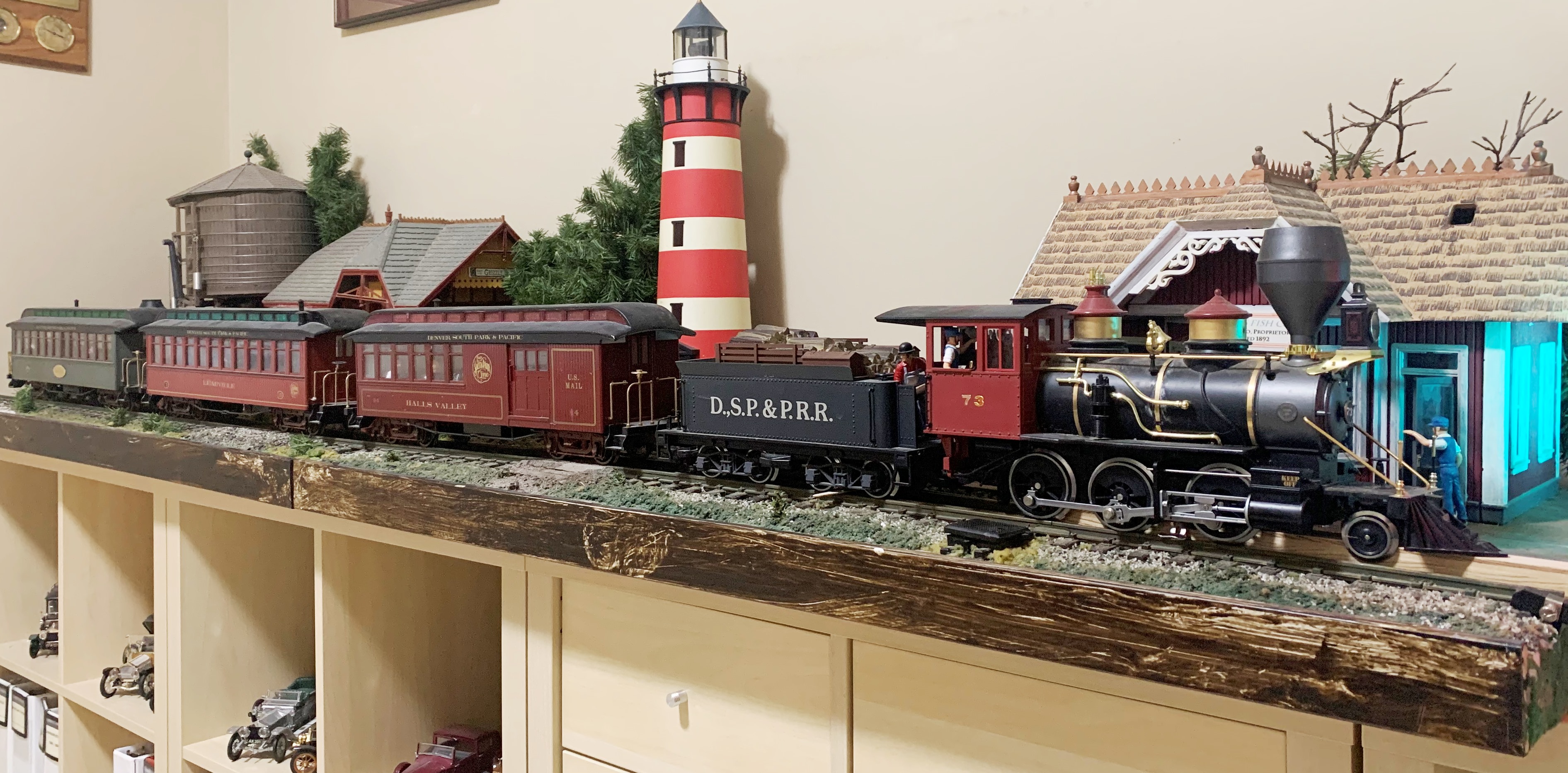
 Touch Up The Details Touch Up The Details
Minor upgrades by painting
cast-in detail or modifying ladders also adds variety and
realism. Lengthening the brake staff is the most important
modification to make the cars look like they really belong on
narrow gauge track. My wife, Sonja, does the fine detail paint
jobs, sometimes with a single-hair brush. I do the
rough weathering and mechanical work.


Cast in door
hooks on LGB reefer touched with black paint (lower right on
left-hand image). In the right-hand image, all hardware, brake
staff, and truss rods were painted black, with ice hatches
removed, air vent and ladders added, and a new road number
inscribed, making the LGB reefer closer to the 1880 prototype.
Steel wheels painted rusty brown look well used compared to the
black plastic originals. Knuckle couples (USA Trains are the
right size) painted grubby brown fix up the end view. I know
body mount link and pin would be more authentic and look better but my curves won't permit this.
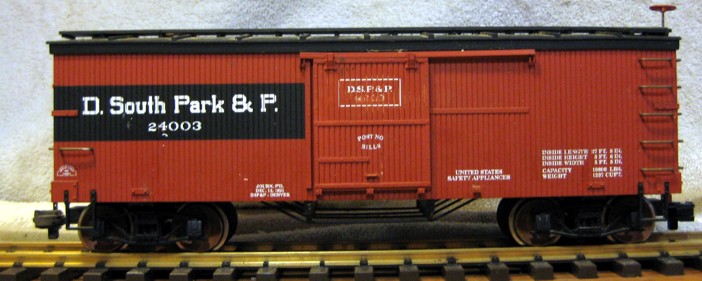
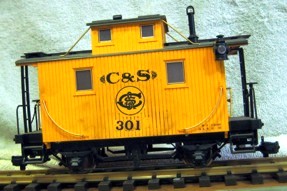
Just correcting the road number on a car can be satisfying. A
little research and some press-on dry transfers lead to more
accurate models.
 Back-date
A Commercial Car To Your Era Back-date
A Commercial Car To Your Era
In my case, I wanted an 1880's
double-board roof on my house cars to replace the 1920's metal
roof on the original product..

The Murphy patented "outside" metal roof didn't arrive until
1905 so no DSP&P car could have carried one until well along in
C&S service.
Converting the poorly rendered Murphy metal roof on the LGB,
Delton, and USA Trains reefers and boxcars to a simulated wood
roof makes a huge difference. The cure is to purchase some well
used Bachman 933xx series boxcars at auction and snap off the
roof - it is simulated wood, and the only one available in
large scale. It needs to be shortened a bit in a miter saw to
replace the Delton and USA Trains roof, and shortened even more
for the LGB cars, then it just snaps into place. Doesn't it look
nice!.
 Add
Parts and Details for Unique Models Add
Parts and Details for Unique Models
Many commercial models are
incomplete or have features that are not quite right for the
model's era or purpose. The examples below show some typical
situations.

The original USA Trains rotary was freelanced into DSP&P
Rotary O2..
To improve visibility in blowing snow, a cupola has been added. A
roof and backhead were added at the rear using Hartland parts,
as were a bell and whistle on the roof. The tender is from an
LGB Mogul with sound added.

Wedge plow O3 sitting in the yard during a summer respite. This is
also my track cleaning car, with emery cloth under the plow
blade and a scrubbing pad under the body. It was kitbashed from
an Aristocraft plow, shortened by 3 inches, with a Hartland
headlamp added to backdate the original modern headlight.

Headshot of DSP&P wedge plow O3 showing rusting plow blade
before it gets scoured clean and shiny by the icy snow next
winter.

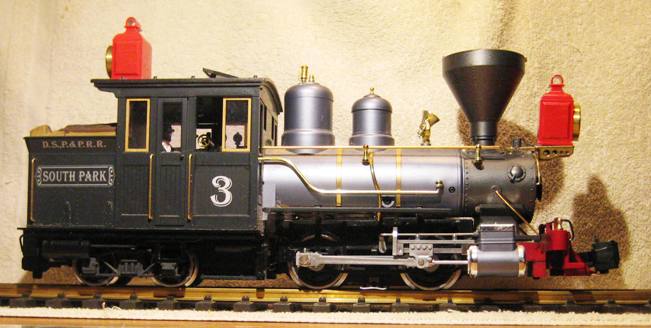
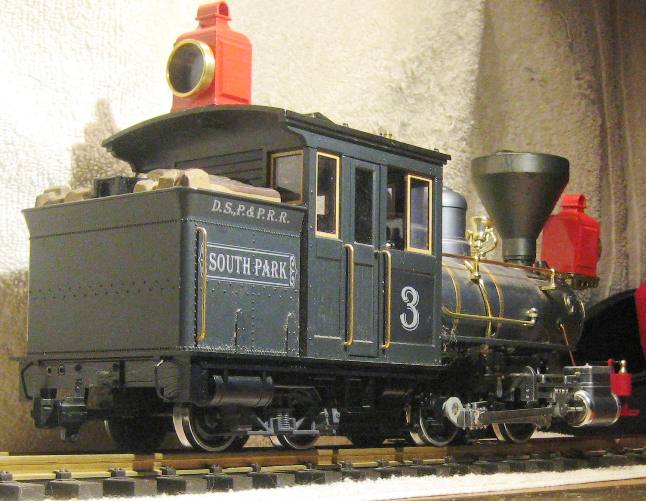
An old-timer with modern headlights just won't do. I added
Hartland headlights to help the
locomotive fit in better.
 More
Elaborate Kit-Bashes More
Elaborate Kit-Bashes
Making completely unique
equipment or performing significant modifications to existing
commercial products is called kit-bashing. Lots of fun can be
had while doing the work, and observers will notice the special
effort.

Steam Shovel O4 can be brought forward to clear the
line of avalanches and rock falls, or to widen a cut or clean up a
ditch. The enclosed cab is a real comfort to the crew in the minus 40
temperatures of the Northern winters. This is kitbashed from an LGB flatcar and
a JS Woodcrafts steam shovel with the track assembly removed.

Add a diesel powered shovel for a more modern ditcher.

Starting with steam shovel parts and some Ozark Miniatures
pulley blocks,
a wrecking crane appears, loosely following a DSP&P folio drawing.

The wrecking crane tender/boom car includes lots of tools, parts,
rope, chains, junk, and a guard goat.

The pile driver uses the same steam hoist with a
free lanced mast holding
the pile driver's hammer.

Swap the
boiler for a locomotive with a different paint job, add a
snow
plow and you have a unique engine on your roster.
 Open
Loads Provide Eye-Opening Interest Open
Loads Provide Eye-Opening Interest
Whether on a flat car or in a
gondola or coal car, a load is a must. Few cars run empty for very long.

Machinery appropriate for the era makes a dull flatcar into a
detailed model.
All you need is some scale chain and a bit of glue.

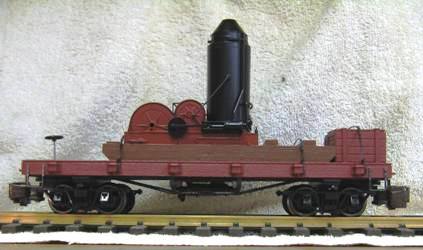

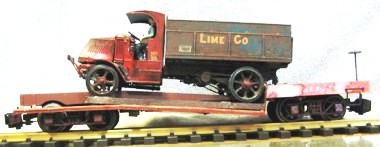
Four more of the open loads on my large scale
outdoor railway.
 Painting
and Lettering for Variety Painting
and Lettering for Variety
Making it uniquely yours.

The right paint, people in the seats, and the car name plaque
give a realistic,
even if somewhat inaccurate, model.
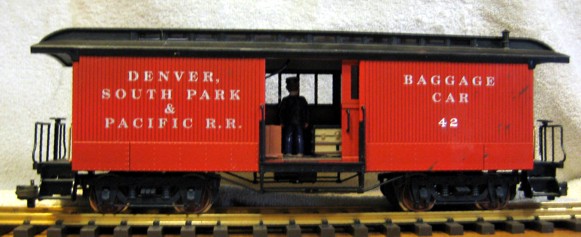
If you can see
inside, there should be something inside to see.
 PHOTO GALLERY #7 - MY 1:1 SCALE DSP&P WAYCAR / TRAIN STORAGE SHED
PHOTO GALLERY #7 - MY 1:1 SCALE DSP&P WAYCAR / TRAIN STORAGE SHED
 It started as a storage problem and
became a full size replica
of DSP&P waycar / caboose #60. It started as a storage problem and
became a full size replica
of DSP&P waycar / caboose #60.
Portions of this
section were published in the
January 2020 issue of "The Bogies and the Loop", the
quarterly magazine of the Denver, South Park and Pacific
Historical Society.
Storing
large scale trains when not in use is always a problem. Several unsatisfactory attempts at storing trains under the patio
seats, and in a screened porch, proved to be cumbersome. Squirrels
loved these hideaways and wind blown debris
was another issue. So I decided to build a human-sized
storage shed. But what kind of shed?
At first I wanted to build a double ended yard so trains could
roll-in and roll-out, but the ladder tracks made the dimensions
impractical. The solution was a transfer table that could be used to
align any train with the inbound and outbound tracks.
My trains max out at 11 to 12 feet in length due to a 3% grade on a
long sweeping curve up Climax Hill. I wanted eight tracks on the
transfer table on 6" centers. That determined the size of the shed
-- roughly 7'7" by 11'9" inside the joists. External
dimensions worked out to 8'4" by 12'8".
I
happened to be browsing my collection of model plans while mulling
over a building design and noticed that the dimensions I needed were
similar to the body of a typical DSP&P Waycar. Finally 2 + 2 made 5
and I decided to build a Waycar replica instead of an ordinary shed.
The actual building is the same length as DSP&P Waycar #64 (see
plans at bottom of this page), but is 5
inches wider to accommodate 8 tracks and 3 inches taller to make the
end doors more humane. The latter also kept the ends in proportion
to the shape of the original car.
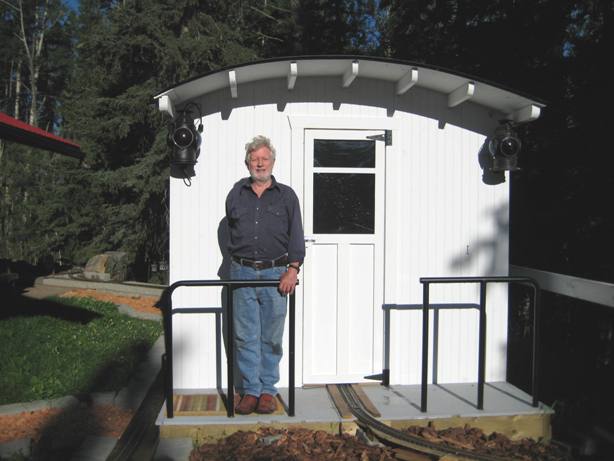

"The Conductor" on his replica waycar Broadside
view of replica waycar #60

DSP&P Waycar # 72 in action around 1884.
My
friend and local contractor/, Jeff Sande, built the structure using the
1:87 (HO scale) plans for Waycar #64, aided by photos of my Accucraft 1:20.3 Waycar.
Construction is standard 2x4 stud walls with V-groove T&G pine
siding. A one-piece black metal roof has no joints, so no leaks. The
railings were bent and welded at the local Carline muffler shop.
Grab irons were fabricated by a neighbour, Doug Hansen, and the
lettering came from a vinyl sign shop, applied by my wife Sonja.
Brakewheel and lanterns came from eBay. Neither are authentic
DSP&P, but who will notice?
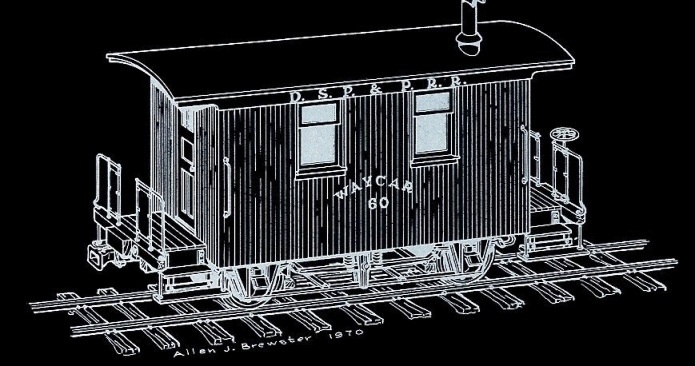
Sketch of Waycar #60 by Allen
J. Brewster, from "Lettering Guide for Early Colorado Narrow Gauge
Freight Cars", published by MNRA, 1970
 THE TRANSFER TABLE THE TRANSFER TABLE
Jeff built the transfer table with 3/4"
plywood framed with 3/4" steel angle-iron. He built rollers from 1"
ball bearings mounted in hand-fabricated trunions.
 These roll in 4
transverse tracks made from 3/4" steel channel. These roll in 4
transverse tracks made from 3/4" steel channel.
 Edge view of transfer table showing roller bearing in 3/4"
channel-iron track, and trunion mounts. Edge view of transfer table showing roller bearing in 3/4"
channel-iron track, and trunion mounts.
Table length is three "4-foot" track sections (141.7 inches,
3600 mm) to eliminate the need to cut any track. The table is a full
4 feet wide to accommodate 8 tracks, but the inside width of the
cabin only needs to be 7' 7" to line up all the tracks to the exit
track, centered in the end doors. With 8
trains on board, the table is heavy but rolls quite easily.
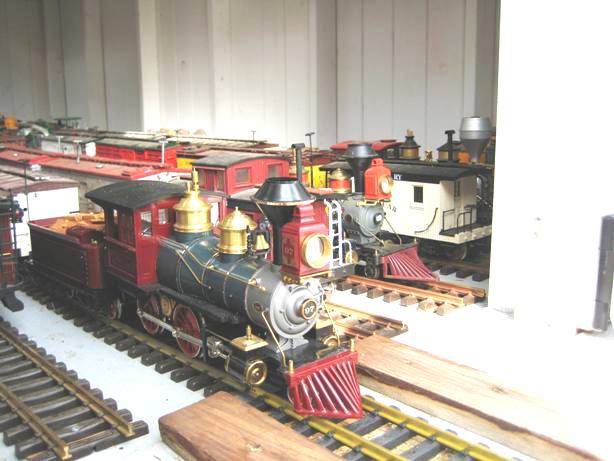 I
wired the 8 tracks with a common outer rail and a switched inner
rail using standard LGB switch boxes. After a bit of settling and
twisting, some track shims were needed at the entrances, but this
was a trivial repair. I
wired the 8 tracks with a common outer rail and a switched inner
rail using standard LGB switch boxes. After a bit of settling and
twisting, some track shims were needed at the entrances, but this
was a trivial repair.
A high stepping 4-4-0 with a short passenger train pulls out of
Track 3 of the transfer table onto the east exit track, headed to
Caboose Junction and the RMH, L&N mainline. 
A large shelf on the inside "back" wall holds all my buildings for winter storage. Two smaller
shelves on the inside "front" wall hold miscellaneous parts, tools,
and repair projects. With the transfer table pushed all the way to
the back wall, all the shelving is easily reached, and entering the
bare floor only needs a bit of cautious footwork at the doorway.
I
am really happy with the transfer table concept for train storage
and with Jeff's construction skills, as well as his faultless
interpretation of the model's plans. My rolling stock stays, clean,
dry, secure, and unmolested by critters, large or small.
 DIMENSIONS FOR DSP&P WAYCAR #64 and #73 DIMENSIONS FOR DSP&P WAYCAR #64 and #73

  Typical dimensions for DSP&P Waycars. Every car was a little
different.
Typical dimensions for DSP&P Waycars. Every car was a little
different.
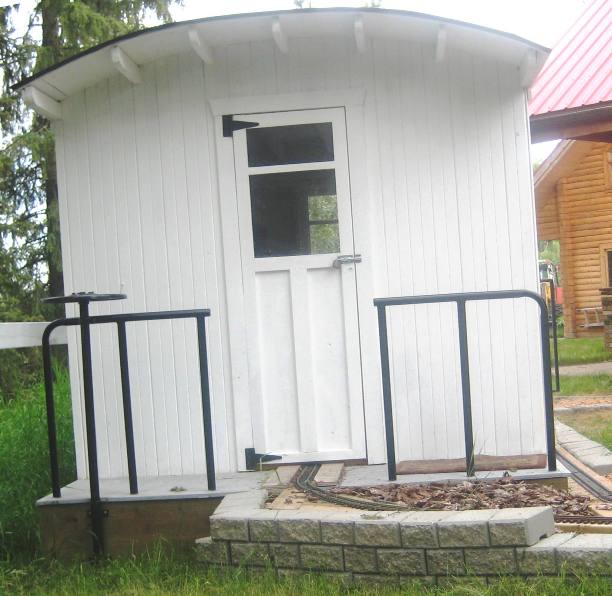
Brakewheel end of my replica of DSP&P waycar #60
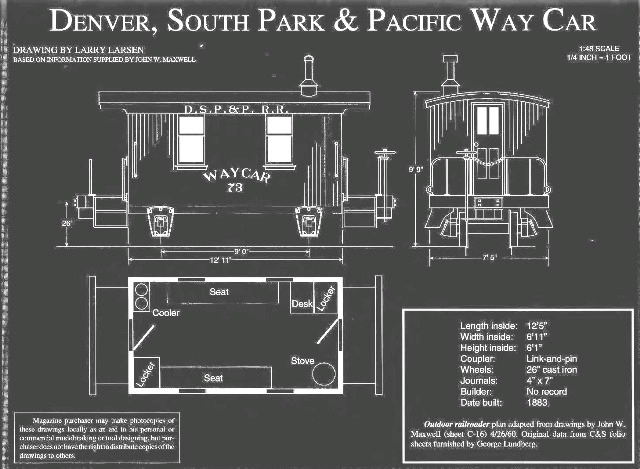
|

 The
DSP&P Northern District operated under the name Rocky Mountain House, Leaverite and Northern Railway.
It was my
outdoor
large scale model railroad, nominally 1:22.5 or G Scale 3 foot
narrow gauge running on Gauge 1 (45 mm) track. It was a
little-known Canadian subsidiary of the Denver, South Park &
Pacific Railroad, serving the fictional towns of Leaverite,
Climax, and
Glacier in west central Alberta. The railway began operations in
2002 and was abandoned in
2017, after the owner moved to a condo in Calgary.
The
DSP&P Northern District operated under the name Rocky Mountain House, Leaverite and Northern Railway.
It was my
outdoor
large scale model railroad, nominally 1:22.5 or G Scale 3 foot
narrow gauge running on Gauge 1 (45 mm) track. It was a
little-known Canadian subsidiary of the Denver, South Park &
Pacific Railroad, serving the fictional towns of Leaverite,
Climax, and
Glacier in west central Alberta. The railway began operations in
2002 and was abandoned in
2017, after the owner moved to a condo in Calgary. 
 The
Okotoks rock weighs in at 16,500 tons and travelled about 400 miles
from Mount Edith Cavell, near Jasper. The biggest rock on the RMH,L&N
weighs 4 tons and is about the size of an old Volkswagon. This
monster, plus a dozen smaller rocks, were found on our ranch as we
cleared bushland for grazing pastures.
The
Okotoks rock weighs in at 16,500 tons and travelled about 400 miles
from Mount Edith Cavell, near Jasper. The biggest rock on the RMH,L&N
weighs 4 tons and is about the size of an old Volkswagon. This
monster, plus a dozen smaller rocks, were found on our ranch as we
cleared bushland for grazing pastures.













































 The RMH,L&N
RR portrays the Denver, South Park and Pacific Railroad around 1880
to 1885, with some minor time-sliding so I can incorporate some
interesting items of rolling stock, like a rotary snowplow and a
Mack AB dump truck on a roll-on roll-off flatcar. I also run C&S
Mogul #5 with its caboose C&S #301 and C&S
Consolidation #30.
The RMH,L&N
RR portrays the Denver, South Park and Pacific Railroad around 1880
to 1885, with some minor time-sliding so I can incorporate some
interesting items of rolling stock, like a rotary snowplow and a
Mack AB dump truck on a roll-on roll-off flatcar. I also run C&S
Mogul #5 with its caboose C&S #301 and C&S
Consolidation #30. 
 The Snow Train
with rotary snow plow and support cars are shown in the photo
essay below. Most of the train is pretty grubby except the caboose
fresh from the paint shop and the new tender for the plow.
The Snow Train
with rotary snow plow and support cars are shown in the photo
essay below. Most of the train is pretty grubby except the caboose
fresh from the paint shop and the new tender for the plow.




































